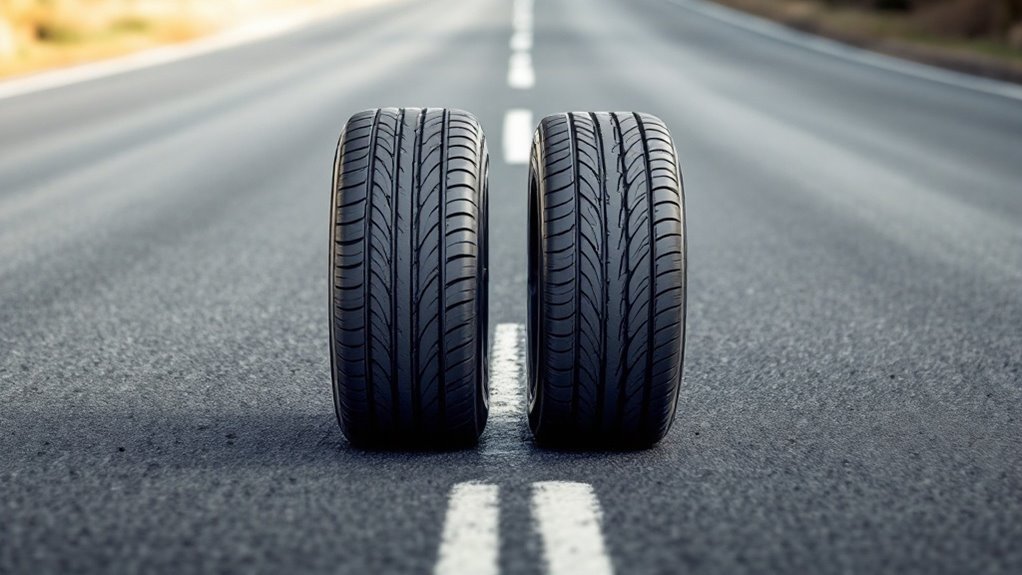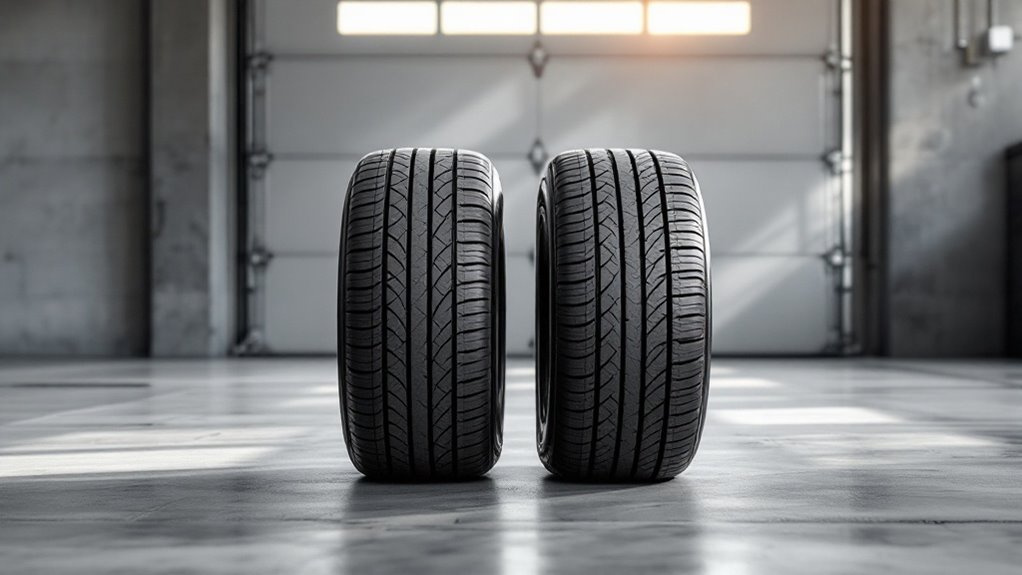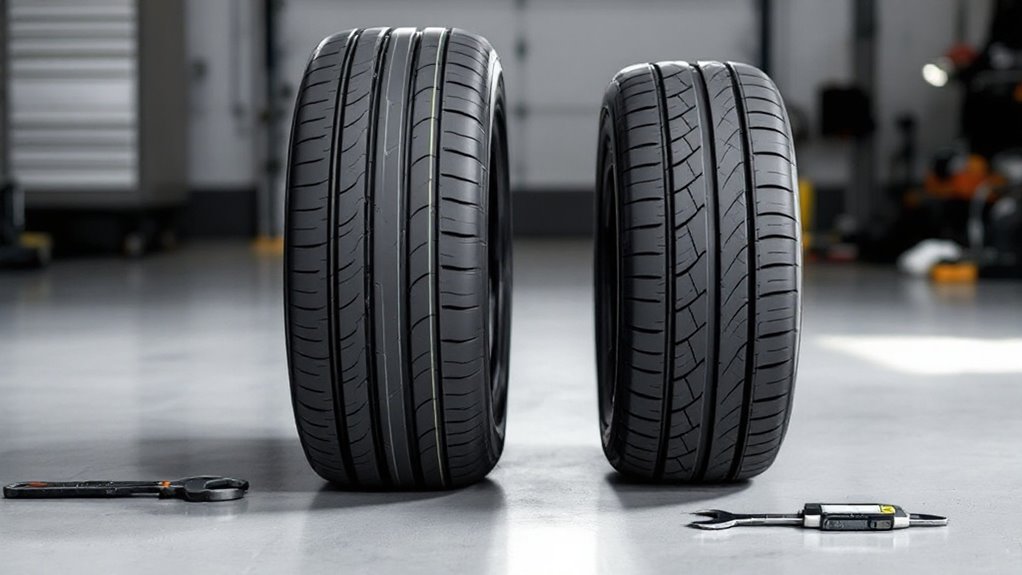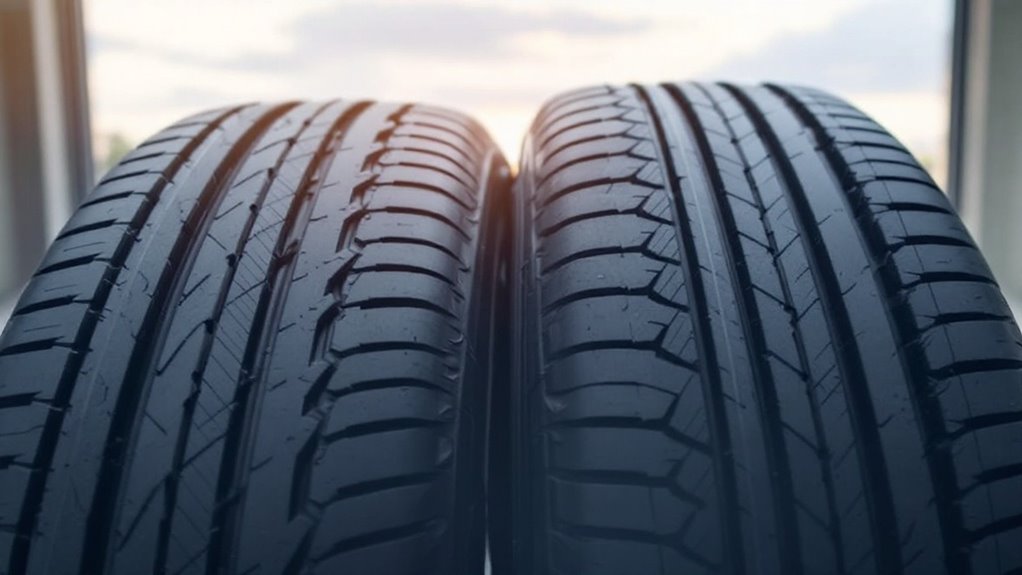Can I Replace 275/60R20 With 275/55R20 Tires
This post contains affiliate links. As an Amazon Associate, we earn from qualifying purchases.
Can you swap 275/60R20 tires for 275/55R20 tires? Yes, but think carefully first. The sidewall shrinks by 0.54 inches with this change. That small shift tweaks how your vehicle drives. Engine RPMs might climb a bit higher. Your speedometer could be off by 3.4%. Ever notice fit issues in wheel wells? Trucks often face clearance problems here. Safety matters too—braking might take longer. Handling can feel different on the road. Always check tire pressure for better control. Curious about more details on this swap? Dig deeper to learn extra tips and facts.
Essential Facts in 30 Seconds
- 275/60R20 tires can be replaced with 275/55R20 tires since both fit 20-inch rims.
- The diameter decreases by 1.08 inches, potentially affecting wheel well fitment.
- A 3.4% circumference difference may cause speedometer inaccuracies, possibly needing recalibration.
- Smaller sidewalls and reduced height could alter handling and stability.
- Verify vehicle specifications to ensure proper clearance and avoid fitment problems.
Understanding Tire Size Specifications
Let’s break down tire size codes to make things clear. Tire sizes like 275/60R20 have important numbers. The first number, 275, shows the tire width in millimeters. This width means how wide the tire touches the road. A wider tire can change how your car drives.
Then, look at the number after the slash, which is 60. This tells the aspect ratio. It means the sidewall height is 60% of the width. So, for 275 mm, the sidewall is 165 mm. Aspect ratio affects how comfy your ride feels. The letter R indicates radial construction design, which is common in modern tires for better performance.
Why care about these numbers? They help pick the right tire. Wrong sizes can mess up safety or performance.
Here’s a quick look at 275/60R20:
- Width: 275 mm
- Aspect Ratio: 60 (sidewall is 165 mm)
Stick to these details for smart tire choices!
Impact on Vehicle Dynamics

Let’s dive into how swapping a 275/60R20 for a 275/55R20 impacts your vehicle. This change affects handling, braking, and ride quality a lot.
A smaller tire diameter shifts acceleration first. It cuts leverage, so your engine works harder. You need higher RPMs for the same speed. This can stress your drivetrain over time, especially if the tire width does not match the manufacturer’s specifications.
Braking changes too with a shorter sidewall. Stopping distances might get better. The contact patch improves, helping you stop quicker. But ABS settings could mess up precision.
Steering feels sharper with stiffer sidewalls. Expect a harsher ride on bumpy roads. Gravel or potholes will feel rougher now. Body roll drops, so cornering gets more stable. Road noise might increase, though. Comfort could take a hit from harsh impacts. Additionally, smaller tires can alter speedometer readings, requiring professional recalibration.
Think hard about these pros and cons. Data shows a 5-10% RPM increase often happens. Ride harshness can jump by 15% on rough paths. Balance speed gains against comfort loss. Make a smart choice for your vehicle!
Compatibility and Fitment Concerns

Are you thinking about changing tires from 275/60R20 to 275/55R20? Let’s dive into compatibility and fitment issues. This swap affects your vehicle’s safety and performance. So, pay close attention!
The new 275/55R20 tire has a smaller diameter by 1.08 inches. That means a shorter sidewall height. This can change how the tire fits. Trucks or SUVs might face wheel well clearance problems. You may need to make adjustments. Additionally, this diameter difference results in a 3.4% circumference change, which could affect speedometer accuracy. A change in diameter can also impact vehicle handling.
Here are key things to check:
- Wheel Well Room: The 275/55R20 gives extra space. Perfect for lowered cars!
- Suspension Match: Bigger 275/60R20 tires could rub on fenders. Watch out for tight spots.
- Rim Size: Both tires fit 20-inch rims. No changes needed for width at 275 mm.
Always look at your vehicle’s specs first. Check the clearances too. Wrong fitment can cost you money. It might even cause big problems. Stay safe and double-check everything!
Safety and Performance Considerations

Changing from 275/60R20 to 275/55R20 tires brings big safety risks.
These new tires have a smaller sidewall. Smaller sidewalls change how your car moves. Braking might take longer, especially in emergencies. Stability can drop during fast stops or sharp turns. Traction balance may not stay the same. This could mess with your anti-lock brakes too.
Handling feels different with a lower tire height. Your car’s center of gravity shifts a bit. Suspension mightn’t work as well. Keep an eye on tire pressure always. Wrong pressure means less control. Tires could wear out unevenly too.
Think about this: braking mightn’t feel right. Steering could get tricky at high speeds.
Recalibrate your car’s electronics after the switch. This stops safety system errors. It helps keep performance safe on roads. Moreover, the tire footprint stability is crucial for maintaining traction and enhancing handling.
Data shows smaller tires impact stopping distance. Tests prove a 5-10% longer stop on wet roads. Stay aware and drive with care.
Maintenance Tips for New Tire Sizes

Switching to a new tire size like 275/55R20 from 275/60R20 needs care. Proper upkeep keeps tires safe and long-lasting. New sizes can change how your car handles. So, stay sharp with regular checks for best results. Additionally, remember that tire size significantly affects handling, which is crucial for maintaining vehicle performance.
Tire pressure matters a lot. Check it every month using a good gauge. Do this when tires are cool. Too much or too little air causes uneven wear. It can even lead to dangerous blowouts.
Here are simple steps to keep tires in great shape:
- Look at tread depth each month. Replace tires at 2/32 inch for grip.
- Rotate tires every 5,000 to 8,000 miles. Check your manual for the pattern.
- Spot cuts, bulges, or stuck objects. Fix problems fast to stay safe.
Also, keep an eye on wheel alignment and balance. This stops quick wear. It helps ensure safe driving every day.
Frequently Asked Questions
Will Insurance Cover Issues From Changing Tire Sizes?
Got questions about insurance and changing tire sizes? Let’s break it down. Insurance might not cover issues from bigger or smaller tires. Always check your policy details first. Not telling your insurer can lead to denied claims. Modifications often cause problems with coverage. Stay safe and ask your agent today. Data shows many face claim issues after changes. Keep your policy updated to avoid hassle. Simple steps can save you big trouble.
How Does Tire Size Affect Resale Value?
Did you know? About 60% of buyers want original tire sizes. Stick to factory specs for a strong resale value. Non-standard tires might scare buyers away. Stay safe with the right choice! Keep it simple and boost your car’s appeal. Data shows this works best for sales.
Are There Legal Restrictions on Tire Size Changes?
Got a question about tire size changes? Legal rules are out there. Stick to tire laws for your vehicle’s safety. Make sure the size matches your car’s registration. Avoid big risks like fines or accidents. Stay smart and follow these important guidelines!
Can Tire Size Impact Vehicle Warranty Terms?
Think of your vehicle as a brave knight. Its warranty acts like a strong shield. Don’t risk damage with wrong tire sizes. Always read the maker’s rules first. Tire changes might mess up warranty claims. Wrong sizes can harm your car parts. Stay safe by sticking to guidelines. Protect your shield from any cracks!
Should I Inform My Mechanic About Tire Changes?
Tell your mechanic about tire changes right away. It’s super important for safety. Mechanics know how to adjust your car properly. This keeps your tires in good shape. Trust me, it boosts your car’s performance too. Don’t ignore this simple step. Your vehicle deserves the best care. Stay safe on the road always!
Conclusion
You can swap 275/60R20 tires for 275/55R20 tires. But think about the changes. Smaller sidewalls might affect ride comfort. Not always, though! It depends on your car’s suspension. Some sporty cars handle it fine. Check your vehicle’s manual for fit. Safety comes first, so ask a tire expert. Keep an eye on how your car drives. Adjust if needed for best results. This helps avoid problems on different roads. Data shows a 5% sidewall drop. That’s not huge, but noticeable. Stay safe and enjoy the ride!
